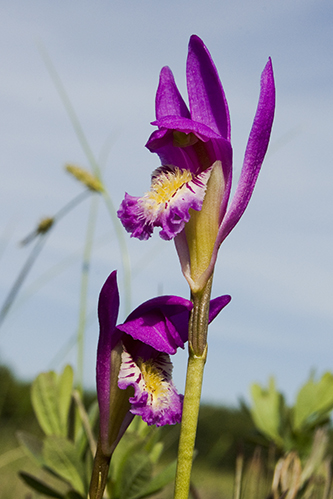Native Plants
Information about what native plants are and the major threats they are facing.
What Are Native Plants?
Native plants are those that occur within their natural range, ecosystem, and habitat without human introduction. This natural range is where the plant has grown and adapted to the conditions of the habitat (climate, soil conditions, light) and co-evolved with other organisms over evolutionary time. Every native plant has a specific native range, some are broad extending across a large area, while others are contained to areas only within a few states.
Native plants are important because they support healthy ecosystems. The co-evolution of plants and organisms means that organisms within a given habitat are dependent on the native plants present. These plants are an important source of food and create necessary habitats for many native animals. A loss of native plants results in loss of diversity in both plants and animals, making ecosystems more susceptible to climate change, disease, and other threats.
What Are The Major Threats To Native Plants?
Human activities are the major threat to native plants due to direct impacts to plants, and alteration or destruction of the native habitat they require.
Activities such as deforestation, unsustainable logging, and large-scale agriculture cause habitat loss and reduce suitable areas for native plants to grow.
Overharvesting threatens plants that are desirable for medication or food because over-exploitation can lead to population loss.
Aquatic plants also face threats from human activities. Vegetation removal along water bodies increases erosion and sediment runoff into the water, and the use of chemical fertilizers, which may also runoff into the water, can negatively impact water quality.
For more information on human impacts and other threats to New England plants read "The State of the Plants" from the Native Plant Trust
An invasive species is a plant or animal that is not native to an area. The introduction of a non-native species has the potential to cause the alteration and degradation of an ecosystem due to their ability to spread quickly and outcompete native species, resulting in their decline.
Invasive plants monopolize resources such as water, sunlight, nutrients, and space. Because these plants spread quickly, they are able to outcompete native species which can reduce biodiversity, reduced suitable habitat, imperil rare species, and degrade water quality.
There are several insects and diseases that are not native to North America that threaten NH forests. Like invasive plants, these pests and diseases spread quickly and can impact whole forest stands. The Oak Wilt Disease, Dutch Elm Disease, Butternut Canker, Chestnut Blight and other introduced diseases have proved devastating to their host species. Introduced non-native insects including the emerald ash borer and Asian longhorned beetle can infest and kill entire stands of hardwood trees.
For more information about invasive species visit the NH Forest Health Pests and Pathogens Page.
Climate change threatens native plants because it makes their native habitats less suitable. Global warming is resulting in the decline of many plants at the limits of their range because the temperature of their habitat is no longer optimal for survival. Plants not at the limit of their range are forced to migrate to higher elevations to find more suitable habitat. Wetland habitats in particular are threatened by sea level rise which causes saltwater to intrude on freshwater areas, damage plants, and alter the composition of salt marshes.
Climate change also causes more dramatic weather events including drought and heat waves which cause stress on the plants thereby lowering their productivity and slowing their growth and ability to spread.
Climate change also exacerbates the other threats to plants such as the ability for invasive species and diseases to spread because stressed plants are more vulnerable to these threats. Invasive species also are more likely to thrive and be resilient to temperature and habitat changes caused by climate change.
For more information on human impacts and other threats to New England plants read "The State of the Plants" from the Native Plant Trust
The information on this page comes from a variety of sources including: National Park Service, University of New Hampshire, Earth.org, World Atlas, University of Maryland Extension, Native Plant Trust, and Grow Native Massachusetts.





